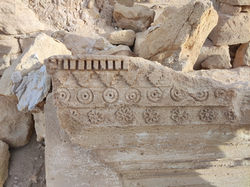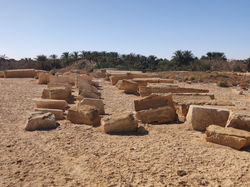Excavations
Excavations of the tomb of Alexander the Great at El Maraki, Siwa Oasis, Egypt
from 1989 to 1995 Liana Souvaltzi led the Greek Mission and from 1995 the united Greek-Egyptian Mission in the excavations of the tomb of Alexander the Great in El Maraki, Siwa Oasis, Egypt. The official international announcement was made by the Egyptian Government about the discovery of the tomb,
in January 29, 1995

Siwa Oasis, Egypt

On January 29, 1995, after an on-site visit by Egyptian experts to the excavations of Liana Souvaltzi at El Maraki in Siwa Oasis, assessment of the findings, study of the inscriptions, and with the agreement of the Egyptian Ministry of Culture, the Secretary General of the Egyptian Organization of Antiquities, Professor Abd El Halim Nur El Din,
announced with warmth and emotion, officially and worldwide, the finding of the Tomb of Alexander the Great!
Our Story
The desert of Siwa is located on the border of Egypt and Libya. It is about 1,000 kilometers from Cairo and 300 kilometers from the Mediterranean coast. At Siwa is the Sanctuary of Ammon Ra or Zeus, the father of the Gods of Egypt.
It was visited by Alexander the Great in 331 BC, who believed himself to be the son of Ra and requested to be buried there after his death. His wish was known to all his generals, including Ptolemy, who according to one version was Philip's illegitimate son. Ptolemy took it as a Country, over which he reigned, Egypt and many other regions in northern Africa.
After the sudden death or assassination according to some historians of Alexander, his body remained in Babylon for two years, because his descendants disagreed about who should receive it and bury it, because he would aspire to become his successor.
During its transfer from Babylon for burial in Siwa it is written that he became its owner, specifically Ptolemy "grabbed" it and buried it in Egypt. It has not been resolved whether after the burial the body remained there, or whether Ptolemy moved it without any publicity to Siwa to comply with Alexander the Great's wish.
The area belonging to the tomb consists of 12,000 square meters, 5,000 square meters of which have been taken up by the excavation. Of this enormous area which is presided over by the monument, and the size of the monument itself which is 51m long and outer width of 10.25m, it is obvious that it could only have been destined for use as a burial monument for the worship of an important person, a King or a God.
The tomb sits on a rock underneath which lies an enormous gold mine, the first found in the Western desert. The structure of the tomb takes the form of a grate", significant traces of which have been found. Generally speaking, this is closed monumental cluster', the dating of which is identical and is indicated by:
1. The strict composition and organisation of the general topographic plan of the closed monumental cluster.
2. The system used to build the three constructions which was irregular rectangular.
3. The similarity in the organisation and composition of the features in the sectional plan of the burial monument and two sanctuaries.
4. The uniform style of paving used for the sacred courtyard at the site.
The site had actually been used as indicated by the finding of votive objects found in the corridor of the tomb, the attrition of the floor in the corridor and sanctuaries and the quantity of ashes found, particularly at the height of the gates SE1 and NW1.
A preliminary study revealed that the building was a large above ground Greek temple shaped Doric burial monument which symbolised the one, the man, the God. in other words, Alexander.
The tomb consists of a propylon, corridor and three chambers. The area is contained by full Doric entabulature, a typical feature of burial monuments characteristic of Macedonian tombs. The presence of corner triglyphs underlines the Greek nature of the monument and the height of the triglyphs (0.71m) indicates the size of the monument. The architectural members found in the area of the three chamber and corridor indicate that the corridor had been built on the inside and had been vaulted and that the roof on the three chamber had probably graded upwards in a form of pyramid like shape.
The triglyphs and metopes are independent. The metopes are almost square with no hexoglyph ornamentation (72 x 68cm) The triglyphs are composed of two complete gabs and two hemigabs in the form of an inward facing two edged corner in between which are located the shank Femur. The horizontal cornice has a vertical continuous face plate and protrudes over the frieze. It is composed of large oblong slates, length 1.44m and width 0.69m. The lower surface projects horizontally. though not along its whole length, and it has mutules with 18 guttae arranged in three series. Along the horizontal cornice runs the gutter or cyma which is concave in form and ends upwards in a perpendicular flat faceplate.
The decorative sculptures of the monument are unique and an excellent example of classical Greek art. The difficulty of using the material they used, the limestone. indicates the skilled craftsmanship required which only Greek craftsmen, whose work was generally characterised by realism and power, could have produced.
Representative classical themes were present, such as the astragal, the egg and dart, the eight petalled rose. leaf-like pieces and open and closed anthemia. The linear decoration and jewellery on the stone surfaces of the burial monument are quite unique. The wonderful epicrane, in fairly good condition, with its marvellously hewed curves at the corners, is a unique find.
The presence of special symbols denoting Alexander were also present, such as the hologlyph lions, the eight beamed star, the disk with the snakes, the acorn tree and the Macedonian shields.
An important point for the study of the tomb and the study of the colours used in classical monuments was that many of the architectural members found, such as the triglyph and horizontal cornice with the mutules had maintained their original colours, in this case, blue.
Some of the metopes had also maintained their terracotta colour. The inscriptions bore traces of white and the abominable lion heads had white, blue and dark red manes. A few sections of the friezes saved from the inside of the corridor maintained the colour on the green leaves and the blue on the anthemia which were similar to lotus flowers on a white background. Part of a frieze on the west side of the corridor wall was also found on 28 September 1993, near the NW3 gate.
The monument would appear to have collapsed in different ways after seismic activity present in the area at the time. The mass of the three chambers collapsed in a different way from the corridor, most of which collapsed to the west. This may have been caused by the earthquake of 221 BC.
The monument was found intact and had not been pillaged and most of the architectural members have been located and removed from their bases. The architectural members are of great worth in terms of their architecture. sculpture and construction and the completion of studies will bring important conclusions about the initial form of the monument and will allow for the monument to be partially reconstructed.
The Political Background
to the excavation of the tomb of Alexander the Great
Unfortunately, in 1996, Christmas day when I went to called the permits for the excavation, which had already been approved, from the office of the General Secretary for Antiquities, then Dr. Al Hassan, I was informed that the Greek Government Rod requested that in Greece our permits be withheld.
At that time Prime Minister was in Greece Mr. Simitis.
We returned to Greece, to start the long process of attempting to uncover the reasons which had led the Greek Government to ad against us, all this despite the fact that the excavation was at a crucial point and was very close to the last stage of the work, very close to the burial chamber of Alexander the Great.
One of the vice presidents of the Greek parliament Mr N. Katsaros of the opposition party New Democracy presented a question in parliament on the matter which was discussed on 6 June 1997.
The results from the parliamentary session were:
1) The Greek Government of that period revealed the goal of this whole exercise, which was that the this excavation must be taken out of my hands either directly or indirectly, and assigned to someone else who, of course, wanted to put their name to whatever has been discovered at the site at Siwa. The person who wanted to replace me was the late Dimitrios Pantermalis
2) The real political motives belind this inviable war which is still continued against me and my work was that the discovery of the Tumb of Alexander the Great, had as a result to arise the pride of Greeks or their national feelings.
In the Beginning I could not believe that the Greek Government of Kosta Simitis would have been able to take such measures against one of there own citizen, who was working in a foreign country, in this case in Egypt, In accordance with the Egyptian Law.
Besides the Greek Mission Was no longer just a team of archaeologists working on their own initiative with private Funding (our money) but was now a joint mission with the support and participation of the Egyptian state in February 1995, and was Known as the Egyptian Greek Mission, in which I still headed the excavations and was entitled to all the rights accompanying the work. I was also able to choose the persons who would work with us on the joint Mission.
All these years, every year we have been applying for permits to the Egyptian Ministry of Antiquities and Tourism... There is not any answer! Maybe because the Egyptian Authorities has Been waiting a movement of goodwill from the Greek side for the offence caused by the Greek insistence on doubting the verity of the international announcement which was made by one of their legal representatives and the illegal intervention of the Greek delegation which had at no time been invited to visit the site nor had they provided for the official permits to visit the archaeological site at the tomb to give their enlightened opinion. The Greek government must openly confirm its wish for the excavations at Siwa to continue and confirm its support for me as leader of the Egyptian-Greek mission. The government has so far refused to carry out this simple act.
The position of the Greek government on this matter as expressed by the Ministry of Culture has directly caused the destruction of this unique Greek monument and its significant finds.
by Liana Souvaltzi
*Postscript
on Sunday, March 17, 2024, the Prime Minister of Greece, Mitsotakis Kyriakos, made a surprise visit to Siwa Oasis and the tomb for reasons of vacation!
https://www.ekathimerini.com/news/1234310/greek-pm-and-egyptian-president-strengthen-partnership/
 |  |  |
|---|---|---|
 |  |  |
 |  |  |
 |  |  |
 |  |  |
 |  |  |
 |

